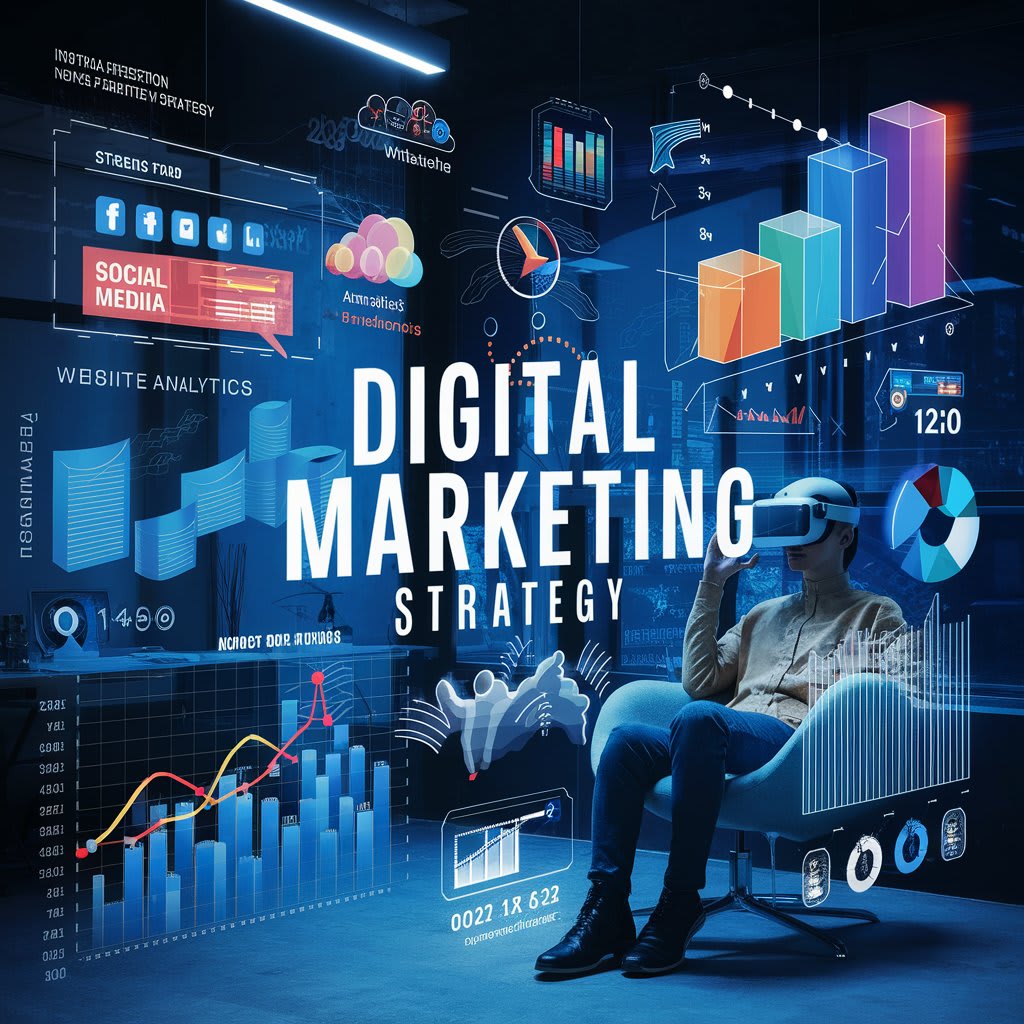Click Magnet: Mastering Paid Advertising Strategies for Digital Domination
Digital Marketing Strategies

In the digital age, attention is currency. For businesses, capturing that attention and converting it into clicks and conversions is the ultimate goal. Paid advertising emerges as a powerful tool in this competitive landscape, allowing you to reach your target audience directly and drive measurable results. This article equips you with essential paid advertising strategies to transform your digital marketing campaigns into click magnets.
Table of Contents
The Paid Advertising Landscape: A Playground of Possibilities
Keyword Mastery: Selecting the Right Words to Attract the Right Audience
Crafting Compelling Ad Copy: Writing Headlines That Captivate and Convert
Landing Page Optimization: The Final Mile of the Click Journey
Targeting Tactics: Reaching Your Ideal Customer with Laser Precision
Creative Campaigns: Capturing Attention in a Visually Driven World
Metrics that Matter: Tracking and Analyzing Performance for Success
Building Your Digital Expertise: Equipping Yourself for the Click Race
Charting Your Course: Choosing the Right Paid Advertising Platform
The Paid Advertising Landscape: A Playground of Possibilities
Paid advertising encompasses a diverse range of platforms and formats. Here are some of the most popular options for digital marketers:
Search Engine Marketing (SEM): Utilize platforms like Google Ads and Microsoft Advertising to place targeted ads at the top of search engine results pages (SERPs) when users search for relevant keywords.
Social Media Advertising: Leverage social media platforms like Facebook Ads, Instagram Ads, and Twitter Ads to reach highly targeted audiences based on demographics, interests, and online behavior.
Display Advertising: Place visually appealing banner ads on high-traffic websites relevant to your target audience.
Native Advertising: Integrate seamlessly with the content of websites and apps, offering a less disruptive and more engaging user experience.
By understanding the various paid advertising options available, you can create a strategic mix that aligns with your campaign goals and target audience.
Keyword Mastery: Selecting the Right Words to Attract the Right Audience
In the world of paid advertising, keywords are the golden ticket. These are the terms and phrases users type into search engines when looking for information or products. Here's how to master keyword selection:
Keyword Research: Conduct thorough keyword research to identify relevant keywords with high search volume and low competition. Tools like Google Keyword Planner and SEMrush can be invaluable in this process.
Targeting Intent: Go beyond just search volume; consider user intent behind specific keywords. Are users looking for information, researching products, or ready to buy? Aligning your ad copy with user intent is crucial for conversions.
Negative Keywords: Utilize negative keywords to exclude irrelevant searches and ensure your ads are reaching the most qualified audience.
Selecting the right keywords sets the foundation for successful paid advertising campaigns. By targeting relevant search terms with high conversion potential, you attract the right users who are more likely to click and convert.
Crafting Compelling Ad Copy: Writing Headlines That Captivate and Convert
In the crowded online space, your ad copy has mere milliseconds to grab attention and compel users to click. Here's how to write headlines that resonate:
Focus on Benefits: Highlight the value proposition of your product or service. What problem does it solve? What benefit does it offer?
Urgency and Scarcity: Create a sense of urgency or scarcity to encourage immediate action.
Clear Calls to Action (CTAs): Tell users exactly what you want them to do, whether it's "Visit Now," "Learn More," or "Shop Now."
A/B Testing: Don't settle for the first draft. Test different headlines and variations using A/B testing to see what resonates best with your audience.
A compelling headline is the first impression your ad makes. By crafting clear, concise, and benefit-driven copy, you can significantly increase your click-through rate (CTR).
Landing Page Optimization: The Final Mile of the Click Journey
The click is just the beginning. The user's journey continues to the landing page, where the conversion magic happens. Here's how to optimize your landing pages for success:
Relevance is King: Ensure your landing page aligns seamlessly with your ad copy. Don't bait-and-switch users with irrelevant content.
Clear Value Proposition: Reiterate the value proposition you highlighted in your ad copy. Explain why users should convert and take the desired action.
Frictionless User Experience: Optimize your landing page for speed and mobile responsiveness. Make it easy for users to find the information they need and complete the desired action.
Compelling CTAs: Reinforce clear calls to action on your landing page, guiding users towards conversion.
Creative Campaigns: Capturing Attention in a Visually Driven World
In today's visually driven world, static text ads might not be enough to cut through the noise. Here's how to leverage creativity to capture attention:
Visual Storytelling: Utilize high-quality images and videos that tell a story, evoke emotion, and connect with your target audience on a deeper level.
Eye-catching Design: Employ strong design principles to create visually appealing ads that stand out from the competition.
A/B Test Visuals: Just like headlines, test different visuals to see what resonates best with your audience and generates the highest click-through rates.
Embrace New Formats: Explore newer ad formats like interactive ads, video ads with shoppable features, and Augmented Reality (AR) experiences to create a more engaging user experience.
By incorporating creative elements into your paid advertising campaigns, you can grab attention, spark interest, and differentiate yourself from the competition.
Metrics that Matter: Tracking and Analyzing Performance for Success
Paid advertising platforms offer a wealth of data and analytics. Here's how to leverage this data to optimize your campaigns for maximum impact:
Impressions and Reach: Track how many times your ad is displayed and the number of unique users it reaches.
Clicks and Click-Through Rate (CTR): Monitor the number of clicks your ad receives and calculate the CTR to understand how effective your ad copy is at attracting clicks.
Conversions and Cost-per-Acquisition (CPA): Track the number of conversions your campaign generates and calculate the CPA to determine the cost of acquiring a new customer.
Return on Investment (ROI): Ultimately, measure the return on investment (ROI) of your paid advertising campaigns. This helps you assess the overall effectiveness of your strategy and identify areas for improvement.
By regularly monitoring and analyzing key metrics, you can gain valuable insights into your campaign performance. This data allows you to optimize your targeting, ad copy, and landing pages, ensuring you achieve the best possible results for your budget.
Building Your Digital Expertise: Equipping Yourself for the Click Race
The world of paid advertising is constantly evolving. Here's how to stay ahead of the curve and become a click magnet:
Consider enrolling in a comprehensive Digital Marketing course that covers various aspects of paid advertising, including keyword research, ad copywriting, landing page optimization, and campaign management.
Stay Updated on Industry Trends: Subscribe to reputable digital marketing blogs, and publications, and attend industry conferences to stay informed about the latest trends and best practices in paid advertising.
Practice Makes Perfect: Experiment with different paid advertising platforms and strategies to gain practical experience and refine your skills.
By investing in your digital marketing knowledge and staying updated with the latest trends, you can equip yourself to excel in the competitive world of paid advertising.
Charting Your Course: Choosing the Right Paid Advertising Platform
The ideal paid advertising platform depends on your specific marketing goals and target audience. Here are some key considerations:
Target Audience: Identify which platforms your target audience frequents the most. Focus your efforts on platforms where you can reach them effectively.
Campaign Goals: Different platforms cater to different goals. Are you aiming for brand awareness, website traffic, or lead generation? Choose a platform that aligns with your objectives.
Budget: Consider your advertising budget when selecting a platform. Some platforms offer more cost-effective options than others.
By carefully evaluating your target audience, goals, and budget, you can choose the most suitable paid advertising platform to maximize your return on investment.
Conclusion
Paid advertising can be a powerful tool in your digital marketing arsenal. By mastering keyword selection, crafting compelling ad copy, optimizing landing pages, and leveraging creative elements, you can transform your campaigns into click magnets, attracting qualified leads and driving conversions. Remember, continuous learning and analysis are crucial for success in the ever-evolving world of paid advertising. With dedication and the right strategies, you can become a true click magnet and achieve your digital marketing goals.
About the Creator
jinesh vora
I'm Jinesh vora, a blogger passionate about Data science, cyber security & Digital Marketing. Here, I share Valuable Insights to help you with Relevant or Authentic Content.
Enjoyed the story? Support the Creator.
Subscribe for free to receive all their stories in your feed. You could also pledge your support or give them a one-off tip, letting them know you appreciate their work.






Comments
There are no comments for this story
Be the first to respond and start the conversation.